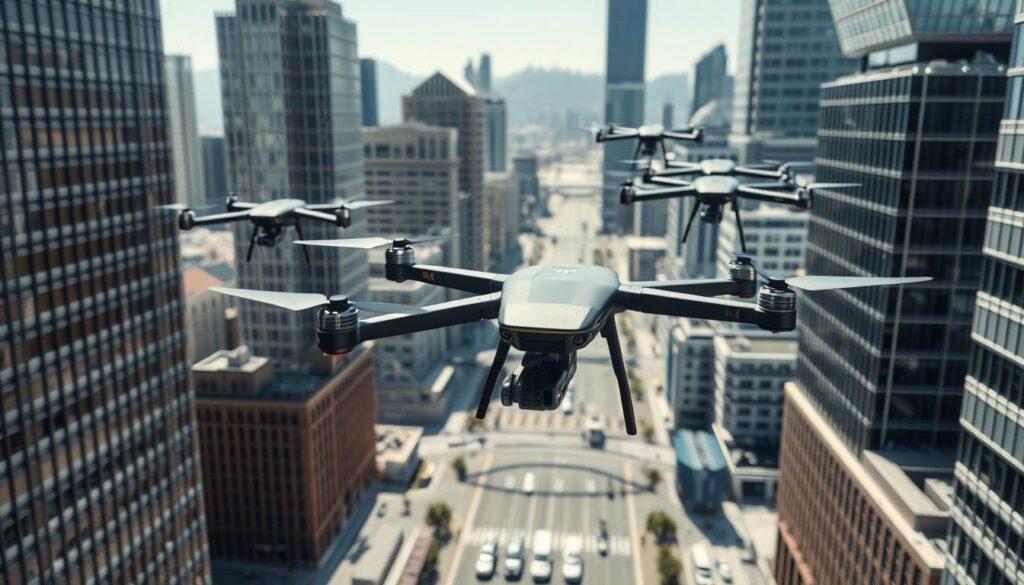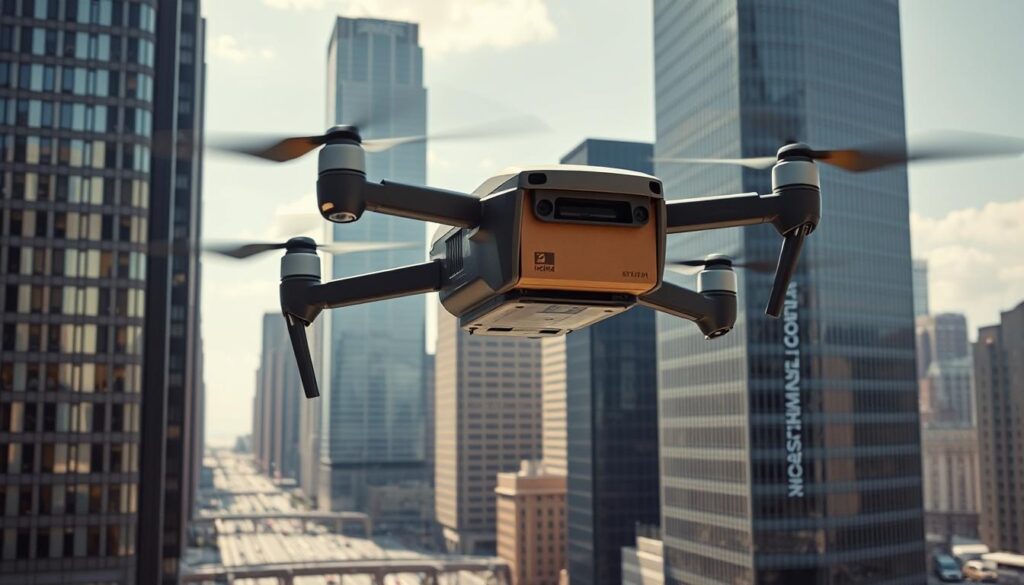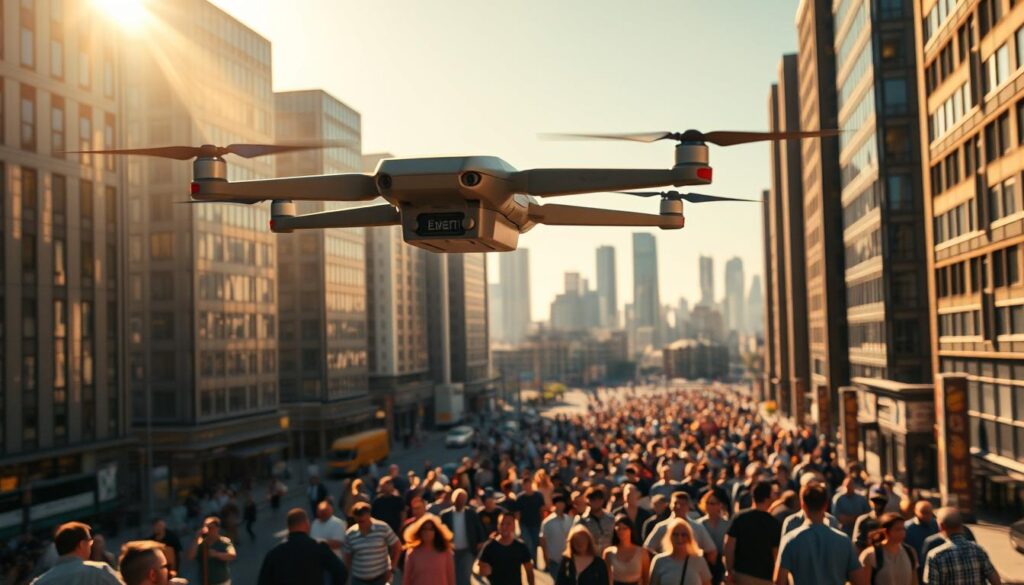On a rainy morning in Dallas, a small bakery kept a promise: warm bread at the door within 20 minutes.
The shop had partnered with a national retailer and a local operator that tested new AI delivery drones. The result was faster service and fewer cold complaints from customers.
![]()
Last-mile costs can eat nearly half of shipping budgets, and labor and traffic make traditional models fragile. In 2025, companies like Amazon, Wing, Walmart, and Zipline have pushed forward with bold pilots and approvals that change the landscape.
This report highlights seven platforms that matter to businesses and customers. We cover how modern technology, cloud integration, and smart sensors improve ETA accuracy and safety. You’ll also see the trade-offs—weather limits, energy density, and regulation—and how partners such as Iottive can help integrate BLE apps and IoT solutions for seamless operations.
Key Takeaways
- Seven leading platforms are shaping rapid, precise package movement in 2025.
- Smart sensors and cloud tools boost ETA accuracy and operational safety.
- Regulatory gains like BVLOS approvals accelerate urban rollout.
- Hybrid networks will balance air and ground to cut costs and emissions.
- Choose partners wisely—build vs. buy matters for speed and scale.
Why last-mile logistics is pivoting to AI delivery drones in 2025
Rising costs and tighter schedules are forcing retailers and carriers to rethink how goods reach front doors.
Last-mile delivery now consumes nearly half of shipping cost for many retailers. Congestion and driver shortages make traditional routes slow and costly. Retailers want narrow windows and near-instant updates, so systems must be faster and smarter.
Iottive builds the foundations retailers and carriers need. Their platform blends BLE, cloud-mobile orchestration, and smart telemetry to turn manual routing into data-driven operations. This helps teams cut idle time and improve ETA accuracy.
Cost, congestion, and customer expectations reshaping the delivery chain
Urban traffic and parking friction increase dwell times. Automation and sky/sidewalk hybrids reduce miles and failed stops. Consumers now expect tight windows and proactive communications.
From pilots to scale: BVLOS permissions, FAA collaborations, and urban trials
Regulatory wins unlocked real growth. In Aug 2024 the UK CAA approved BVLOS testing. U.S. pilots with the FAA and partnerships in Dallas moved 15-minute drops into real markets. These steps let operators expand operations across areas and environments.

| Challenge | What helps | Near-term result |
|---|---|---|
| High cost-to-serve | Cloud software + telemetry | Lower miles, fewer failed stops |
| Urban congestion | Aerial corridors & smart routing | Shorter transit time |
| Labor shortages | Automation & operator assist | Higher productivity |
Top 7 AI-powered drones and platforms transforming autonomous parcel delivery
A new generation of aerial platforms is redefining how stores route small, time-sensitive orders to customers.

Amazon Prime Air MK30 uses lighter, quieter props and improved weather resilience. Tests in Italy (Dec 2024) and limited sites in CA and TX show lower noise and rain tolerance.
Alphabet’s Wing
Wing’s retail partnerships and a DoorDash tie-in (Dec 2024) illustrate how marketplaces can promise 15-minute windows by embedding flight slots into checkout flows.
Zipline
Zipline’s fixed-wing fleet has completed 600,000+ deliveries and nearly 100 million miles, proving range and reliability for medical and retail runs.
Walmart’s DroneUp network
Walmart blends partners like Zipline and DroneUp to hit sub-30-minute targets across multi-state corridors and varied environments.
Manna X-drone
Manna’s rotorcraft carries up to 3.5 kg at 80 km/h and supports seven to eight deliveries per hour—a model for dense urban food runs.
UPS Flight Forward
UPS focuses on healthcare logistics, certified operations, and regulated airspace to move time-critical packages with tight safety controls.
Flirtey / SkyDrop
Flirtey raised payload to 3.5 kg, added a parachute system and 60 m precision drops; commercial trials with Domino’s NZ are underway.
- Why it matters: These companies map trade-offs in capacity, speed, safety, and routes so operators can pick models that match their service and regulatory needs.
- Where Iottive fits: Iottive supports OEMs and platforms with BLE apps, mobile-cloud integration, and custom products that sync flight telemetry, package ID, and customer notifications end to end.
| Platform | Key advantage | Notable metric |
|---|---|---|
| Amazon Prime Air MK30 | Quieter props, light-rain resilience | 25% lower perceived noise vs MK27-2 |
| Wing | Marketplace integration for rapid slots | 15-minute DoorDash partnership (DFW) |
| Zipline | Range and reliability | 600K+ deliveries; ~100M miles |
| Manna | High urban throughput | 3.5 kg, 7–8 drops/hour; 100K+ deliveries |
AI, IoT last-mile tracking, and cloud-based orchestration behind drone delivery
Smart orchestration layers now stitch weather, traffic, and crew data into reliable windows for customers.
Predictive ETAs and hybrid routing combine live weather, traffic feeds, crew performance, and cost metrics to generate tight time windows. Mature ML models can reach up to 98% ETA accuracy, while route optimization cuts miles by 10%+ and lowers total supply costs.
Real-time telemetry
BLE and 5G sensors stream package ID, condition, and chain-of-custody events to central systems. These feeds reconcile proof-of-handling with instant customer updates and fewer exceptions.
Driver and operator enablement
Voice briefs, stop intelligence, and guided exception handling shorten dwell times. Operator tools reduce hand-off errors and improve on-the-ground management across mixed routes.
Cloud vs on-prem
Cloud-first software scales quickly for peak times and rapid rollouts. On-prem remains for strict compliance, but most operations favor cloud agility for fast improvements and lower infrastructure costs.

- Where Iottive fits: End-to-end integration, BLE app development, cloud & mobile sync, and custom IoT products that bridge flight, sensor, and mobile endpoints for measurable efficiency gains.
| Feature | Benefit | Metric |
|---|---|---|
| Predictive ETAs | Reliable windows | Up to 98% accuracy |
| Hybrid routing | Fewer miles | 10%+ reduction |
| Secure telemetry | Proof-of-chain | Instant reconciliation |
Benefits and risks: Speed, sustainability, and the roadblocks to scale
A balanced network of aerial craft and ground robots lets operators tune cost and speed by area.
Operational gains are tangible: route optimization cuts miles by up to 10%+, supports sub-30-minute windows, and can push ETA accuracy toward 98% with mature models.
Efficiency and safety in real operations
These efficiency wins lower cost and improve on-time rates for customers. Sensors and cloud systems help teams spot exceptions and keep safety margins tight.
Sustainability edge
Electric flight can cut greenhouse gases by up to 84% per package and use as much as 94% less energy than diesel trucks. That matters for corporate supply goals and urban emissions targets.
Constraints to solve
Real risks remain: weather sensitivity, limited payload capacity, battery energy density, noise, privacy concerns, and strict safety rules. Public acceptance and permitting also shape rollout speed.
Ground robots vs aerial craft
Robots offer higher capacity and fewer airspace issues but trade off speed and need sidewalk infrastructure. A blended approach matches systems to environments and traffic patterns.
“Operators should tie telemetry and sensor data to KPIs to prove ROI — ETA accuracy, on-time rates, and reduced miles tell the story.”

| Benefit | Risk | Impact |
|---|---|---|
| Fewer miles (10%+) | Weather sensitivity | Lower cost-to-serve |
| Sub-30-minute windows | Payload limits | Higher customer satisfaction |
| 84% lower GHG | Noise & privacy | Stronger sustainability claims |
Market signals: Real deployments, quick commerce momentum, and 2025 outlook
Real-world pilots are shifting from laboratory tests to paid routes in cities and rural corridors.
Q-commerce momentum is clear. Dark stores and micro-fulfillment bring stock closer to shoppers. That makes under-one-hour SLAs achievable for many retail and grocery operations.

Q-commerce acceleration
Rapid runs use compact hubs to cut routes and traffic exposure. Companies pair software with local micro-fulfillment to shave minutes off orders.
Healthcare and emergency use cases
Medical runs now carry blood and vaccines to remote clinics and disaster zones. NHS projects in the Scottish Highlands show urgent supplies can reach patients when roads fail.
Regulatory progress
Regulators are opening paths for scale: the UK CAA BVLOS rulings and FAA partnerships with firms like Wing support broader urban UTM evolution. These moves create safer, more efficient corridors.
What leaders are measuring
Operators focus on cost-to-serve, on-time rates, clear customer comms, and NPS. Those KPIs show whether new systems improve supply chain performance and service quality.
Build vs partner
Many businesses weigh in-house builds against vendor platforms. Iottive partners with enterprises to evaluate build-vs-buy and speed integration via BLE apps and mobile-cloud systems.
“Combine off-the-shelf platforms with bespoke modules to hit market fast while keeping control over core operations.”
Practical roadmap: prioritize compliance, safety cases, infrastructure, and software integration to avoid bottlenecks during deployment.
| Area | Signal | Near-term impact | Example |
|---|---|---|---|
| Q-commerce | Dark stores + micro-fulfillment | Under-1-hour SLAs in dense areas | Retail chains testing rapid grocery runs |
| Healthcare | Urgent medical runs | Faster critical kit access in remote zones | NHS Scotland vaccine transport |
| Regulation | BVLOS and UTM updates | Safer, longer routes; scaled operations | UK CAA BVLOS; FAA urban partnerships |
| Operations | Metrics & partnerships | Validated ROI and faster time-to-value | Iottive integration for BLE and cloud |
Conclusion
A pragmatic blend of air and ground robots gives businesses a clear path to faster service and lower cost. Operators that pair aircraft, vans, and street robots match payloads to neighborhoods and keep safety and community impact front and center.
Integrated systems—sensors, BLE apps, and cloud platforms—turn telemetry into reliable ETAs and measurable improvements. AI‑driven routing can cut miles by up to 10% and reach about 98% ETA accuracy in mature setups.
Regulatory progress and better infrastructure will speed scale. Investment cases should link reduced time and miles to dashboards that leaders use for tradeoffs in labor and safety.
Iottive helps businesses operationalize the future with end‑to‑end solutions: BLE app development, cloud & mobile integration, and custom products. Start your roadmap: www.iottive.com | sales@iottive.com
FAQ
What makes these 2025 drone platforms different from earlier models?
Advances in onboard processing, quieter motors, improved weather tolerance, and better battery energy density let newer platforms fly longer, carry more, and operate in denser urban airspace. Cloud orchestration and edge compute give pilots and operators richer telemetry and predictive routing, reducing delays and exceptions.
How do regulations like BVLOS and FAA pathways affect rollout?
BVLOS approvals and FAA pilot programs are critical. They set operational limits, safety standards, and airspace rules that allow scale. Gaining permissions often requires robust detect-and-avoid systems, redundant comms, and documented safety cases — plus collaboration with local air traffic authorities.
Which companies lead commercial medical and retail missions?
Companies such as Zipline, UPS Flight Forward, Wing (Alphabet), Amazon Prime Air, Walmart’s DroneUp, Manna, and Flirtey have distinct strengths — from long-range fixed-wing runs for hospitals to dense urban point-to-point drops for retail. Each focuses on specific payloads, corridors, and regulatory niches.
How do on-ground robots compare to aerial vehicles for urban last-mile work?
Ground robots excel in heavy, high-capacity, short-range moves where surface infrastructure exists. Aerial vehicles win on speed and bypassing traffic. Trade-offs include noise, payload limits, and energy density for drones, versus sidewalk regulations and slower transit for robots.
What role does networked telemetry and sensors play in safe operations?
Telemetry from BLE, 5G, and other sensors supplies real-time position, package condition, and chain-of-custody data. That information feeds cloud orchestration systems to trigger contingency routing, operator alerts, and customer notifications — improving ETA accuracy and trust.
Can companies retrofit existing fleets with the orchestration tools they need?
Yes. Many software platforms offer hybrid on-prem and cloud modules so operators can integrate telemetry, routing, and voice-enabled operator tools without full hardware swaps. This reduces upfront costs and speeds pilots-to-scale transitions.
How much do these systems reduce emissions compared to truck routes?
Studies and field deployments show electric aerial and robotic systems can cut greenhouse gas emissions per parcel by large margins — in some cases up to roughly 80% lower — depending on route density, battery sourcing, and the replaced truck segment.
What are the main constraints still blocking mass adoption?
Key barriers include weather resilience, limited payload and flight time, energy density of batteries, urban noise, privacy concerns, and the need for mature detect-and-avoid certification. Solving those requires tech, regulation, and public acceptance.
How do companies measure success for these programs?
Operators track cost-to-serve, on-time rates, ETA accuracy, customer satisfaction and NPS, mission safety events, and utilization. Those KPIs guide whether to build internal capabilities or partner with specialized providers.
Are there proven emergency or healthcare use cases today?
Yes. Zipline and UPS Flight Forward have well-documented medical missions delivering blood, vaccines, and lab samples. These missions prioritize reliability, secure chain-of-custody, and certified airspace operations to meet clinical requirements.
What should a retailer consider when choosing between building or partnering?
Assess core competencies, capital readiness, speed-to-market needs, regulatory burden, and integration complexity. Partnering often accelerates deployments and reduces regulatory risk; building gives deeper control but demands large up-front investment and operational expertise.
How do predictive ETAs and hybrid routing improve customer experience?
Predictive models use weather, traffic, vehicle state, and historical trends to set reliable ETAs. Hybrid routing — mixing ground and air legs — optimizes cost and speed, enabling narrower delivery windows and higher on-time performance.
What safety systems are standard on certified commercial platforms?
Certified platforms typically include redundant propulsion, geofencing, detect-and-avoid sensors, secure comms, parachute or controlled-landing options for failures, and encrypted telemetry for chain-of-custody and audit trails.
How do operators handle noisy environments and urban privacy concerns?
Operators choose quieter propeller designs, limit flight hours, and create transparent community engagement programs. Privacy is addressed by minimizing onboard imaging, anonymizing telemetry, and complying with local data protection rules.
What infrastructure investments speed up scaling across cities?
Key investments include vertiports or landing pads, micro-fulfillment hubs near demand centers, secure charging stations, resilient 5G or private networks, and UTM-compatible traffic management integrations to coordinate flights safely.
Transform Your IoT Vision Into Reality.
Get free expert insights, architectures & cost breakdowns.
Drop you email to schedule free meeting.